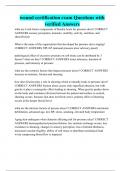wound certification exam Questions with
verified Answers
what are 6 risk factor components of Braden Scale for pressure ulcer? CORRECT ANSWERS sensory perception, moisture, mobility, activity, nutrition, and shear/friction
What is the name of the organization that developed the pressure ulcer staging? CORRECT ANSWERS NPUAP (national pressure ulcer advisory panel)
pathological effect of excessive pressure on soft tissue can be attributed by 3 factors? what are they? CORRECT ANSWERS tissue tolerance, duration of pressure, and intensity of pressure
what are the extrinsic factors that impact pressure ulcers? CORRECT ANSWERS increase in moisture, friction and shearing
how does friction play a role in shearing which eventually leads to pressure ulcer? CORRECT ANSWERS friction alone causes only superfical abrasion, but with gravity it plays a synergistic effect leading to shearing. When gravity pushes down on the body and resistance (friction) between the patient and surface is exerted, shearing occurs. because skin does not freely move, primary effect of shearing occurs at the deeper fascial level.
what are the intrisinc factors of pressur ulcers? CORRECT ANSWERS nutritional debilitation, advanced age, low BP, stress, smoking, elevated body temperature
Aging skin undergoes what elements affecting risk for pressure ulcer? CORRECT ANSWERS dermoepidermal junction flattens, less nutrient exchange occurs, less resistance to shearing, changes in sensory perception, loss of dermal thickness, increased vascular fragility; ability of soft tisuse to distribute mechanical load w/out comprosing blood flow is impaired What does nonblanching erythema indicate in the skin r/t PU? CORRECT ANSWERS when pressure is applied to the erythematic area skin becomes white (blanched), but once relieved, erythema returns -indicating blood flow; however in nonblanching erythema, skin does not blanche-indicating impaired blood flow-
suggesting tissue destructon
why does sitting in a chair pose more of a risk in skin break down than lying? CORRECT ANSWERS deep tissue injury or PU is likely to occur sooner sitting down because tissue offloading over boney prominences is higher
Describe what you will see in deep tissue injury? CORRECT ANSWERS purple or
maroon localized area of discolored intact skin skinor blood filled blister; may be preceded by painful, firm, mushy, or boggy; skin may be warmer to cooler in adjacent tissue. In dark skin, thin blister or eschar over a dark wound bed may bee seen
Describe stage I pressure ulcer? CORRECT ANSWERS Intact skin with nonblanchable redness of localized area. Will not see blanching in dark skin, but changes in skin tissue consistency (firm vs boggy when palpated), sensation (pain),
and warmer or cooler temperature may differ from surrounding area
Describe stage II pressure ulcer? CORRECT ANSWERS partial-thickness wound where epidermis and tip of dermis is lost with red-pink wound bed w/out slough. may also present as intact or open/ruptured serum -filled blister
Describe stage III pressure ulcer? CORRECT ANSWERS full-thickness wound where both epidermis and dermis is lost and subcutaneous tissue may be visible, but deeper structures such as muscle, bone, and tendon are not exposed; slough my
be present but it doesn't obscure depth and tunneling and undermining may be present
Describe stage IV pressure ulcer? CORRECT ANSWERS full-thickness wound with exposed bone,tendon, and muscle; slough or eschar may be seen in some parts
of the wound bed. you will often see tunneling and undermining. Osteomyelitis may be dxed at this stage, since bone is palpable Describe unstageble ulcers? CORRECT ANSWERS full-thickness wound where base of the ulcer is covered by slough and/or eschar, obscuring depth
When should eschars not be removed? CORRECT ANSWERS when it's stable with dry, adherent, and intact w/out erythema on the heel; this serves as the body's natural cover and should not be removed.
Therapeutic function of pressure distribution is accomplised by what 2 factors? CORRECT ANSWERS immersion and envelopement
Define immersion? CORRECT ANSWERS depth of penetration or skining into surgace allowing pressure to be spread out over surrounding area rather than directly over boney prominence
Define envelopement? CORRECT ANSWERS is the ability of support surface to conform to irregularities without causing substantial increase in pressure
what is bottoming out? CORRECT ANSWERS this occurs when depth of penetration or sinking is excessive, allowing increased pressure to concentrate over
boney prominences
what factors contribute to bottoming out? CORRECT ANSWERS weight, disproportion of weight and size such as amputation, tendency to keep HOB >30 degrees, inappropriate support surface settings
When should you consider reactive support surface with features and components such as low air loss, alternating pressure, viscous or air fluids? CORRECT ANSWERS for patients who cannot effectively position off their wound, have PUs
in multiple turning surfaces, or have PUs that fail to improve despite optimal comprehensive management
When should active support surface be considered? CORRECT ANSWERS when effective positioning is determined by an MD to be medically contraindicated




